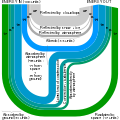
Back Portal:Klimawandel German Portail:Changement climatique French Portaal:Opwarming van de Aarde Dutch Cổng thông tin:Biến đổi khí hậu Vietnamese
The Climate Change Portal Present-day climate change includes both global warming—the ongoing increase in global average temperature—and its wider effects on Earth’s climate system. Climate change in a broader sense also includes previous long-term changes to Earth's climate. The current rise in global temperatures is driven by human activities, especially fossil fuel burning since the Industrial Revolution. Fossil fuel use, deforestation, and some agricultural and industrial practices release greenhouse gases. These gases absorb some of the heat that the Earth radiates after it warms from sunlight, warming the lower atmosphere. Carbon dioxide, the primary gas driving global warming, has increased in concentration by about 50% since the pre-industrial era to levels not seen for millions of years. Climate change has an increasingly large impact on the environment. Deserts are expanding, while heat waves and wildfires are becoming more common. Amplified warming in the Arctic has contributed to thawing permafrost, retreat of glaciers and sea ice decline. Higher temperatures are also causing more intense storms, droughts, and other weather extremes. Rapid environmental change in mountains, coral reefs, and the Arctic is forcing many species to relocate or become extinct. Even if efforts to minimize future warming are successful, some effects will continue for centuries. These include ocean heating, ocean acidification and sea level rise. Climate change threatens people with increased flooding, extreme heat, increased food and water scarcity, more disease, and economic loss. Human migration and conflict can also be a result. The World Health Organization calls climate change one of the biggest threats to global health in the 21st century. Societies and ecosystems will experience more severe risks without action to limit warming. Adapting to climate change through efforts like flood control measures or drought-resistant crops partially reduces climate change risks, although some limits to adaptation have already been reached. Poorer communities are responsible for a small share of global emissions, yet have the least ability to adapt and are most vulnerable to climate change. Many climate change impacts have been observed in the first decades of the 21st century, with 2024 the warmest on record at +1.60 °C (2.88 °F) since regular tracking began in 1850. Additional warming will increase these impacts and can trigger tipping points, such as melting all of the Greenland ice sheet. Under the 2015 Paris Agreement, nations collectively agreed to keep warming "well under 2 °C". However, with pledges made under the Agreement, global warming would still reach about 2.8 °C (5.0 °F) by the end of the century. Limiting warming to 1.5 °C would require halving emissions by 2030 and achieving net-zero emissions by 2050. Fossil fuel use can be phased out by conserving energy and switching to energy sources that do not produce significant carbon pollution. These energy sources include wind, solar, hydro, and nuclear power. Cleanly generated electricity can replace fossil fuels for powering transportation, heating buildings, and running industrial processes. Carbon can also be removed from the atmosphere, for instance by increasing forest cover and farming with methods that capture carbon in soil. (Full article...) Selected article – Greenhouse gases (GHGs) are the gases in the atmosphere that raise the surface temperature of planets such as the Earth. Unlike other gases, greenhouse gases absorb the radiations that a planet emits, resulting in the greenhouse effect. The Earth is warmed by sunlight, causing its surface to radiate heat, which is then mostly absorbed by greenhouse gases. Without greenhouse gases in the atmosphere, the average temperature of Earth's surface would be about −18 °C (0 °F), rather than the present average of 15 °C (59 °F). The five most abundant greenhouse gases in Earth's atmosphere, listed in decreasing order of average global mole fraction, are: water vapor, carbon dioxide, methane, nitrous oxide, ozone. Other greenhouse gases of concern include chlorofluorocarbons (CFCs and HCFCs), hydrofluorocarbons (HFCs), perfluorocarbons, SF Human activities since the beginning of the Industrial Revolution (around 1750) have increased carbon dioxide by over 50%, and methane levels by 150%. Carbon dioxide emissions are causing about three-quarters of global warming, while methane emissions cause most of the rest. The vast majority of carbon dioxide emissions by humans come from the burning of fossil fuels, with remaining contributions from agriculture and industry. Methane emissions originate from agriculture, fossil fuel production, waste, and other sources. The carbon cycle takes thousands of years to fully absorb CO2 from the atmosphere, while methane lasts in the atmosphere for an average of only 12 years. (Full article...) Selected picture –The collapse of Larsen B Ice Shelf, showing the diminishing extent of the shelf from 1998 to 2002
WikiProjectsIn the newsAdditional News
Selected biography –Greg Jackson CBE (born September 1971) is a British entrepreneur and businessman who is the founder and CEO of Octopus Energy, the largest electricity supplier in the United Kingdom, serving over seven million households and active in 27 countries. (Full article...) General imagesThe following are images from various climate-related articles on Wikipedia.
Did you know –Related portalsSelected panorama –Credit: NASA/Goddard Space Flight Center Plant Productivity in a Warming World: The past decade is the warmest on record since instrumental measurements began in the 1880s. Previous research suggested that in the '80s and '90s, warmer global temperatures and higher levels of precipitation—factors associated with climate change—were generally good for plant productivity. An updated analysis published this week in Science indicates that as temperatures have continued to rise, the benefits to plants are now overwhelmed by longer and more frequent droughts. High-resolution data from the Moderate-Resolution Imaging Spectroradiometer, or MODIS, indicate a net decrease in net primary production (NPP) from 2000-2009, as compared to the previous two decades. This narrated video gives an overview of NPP and the carbon cycle.
Topics
CategoriesWeb resources
Things to do
WikimediaReferences
Discover Wikipedia using portals
|
© MMXXIII Rich X Search. We shall prevail. All rights reserved. Rich X Search







































































